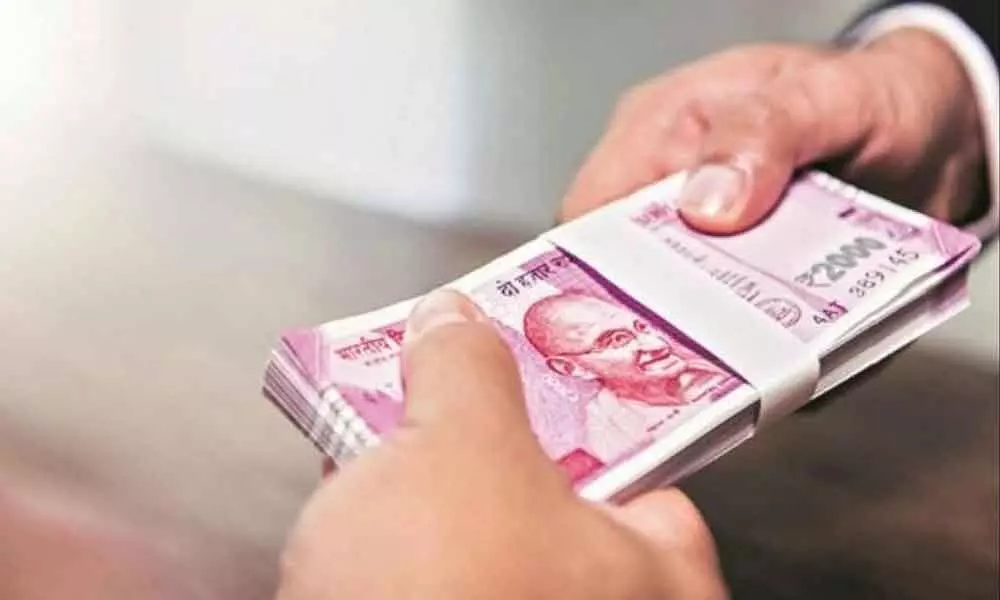Live
- RG Kar tragedy: Statement of forensic doctor who took pictures of victim’s body crucial for CBI
- Include Valmiki community in ST list, MP Ambica pleads
- Chandrababu Advocates Strict Measures for Social Welfare and Infrastructure Development in AP
- Show of brotherhood by Vijayan, Stalin at event to honour Dravidian icon
- District Collectors’ conference with CM begins
- Celebrations kick off in Saudi Arabia to welcome FIFA World Cup 2034
- Google Unveils Jules AI to Help Developers Fix Code Errors
- Bengaluru Techie’s Tragic Suicide Sparks Outrage Over Family Disputes and Legal Failures
- Crucial Union Cabinet meeting to discuss One Nation One Election
- Irrigation AE Nikhesh Kumar Arrested in Disproportionate Assets Case, Granted 4-Day Custody
Just In
Are 7-times salaries of govt staff justified?


Representational image
The objective of the government is to secure the welfare of its citizens, according to our Constitution. Indeed, the government employees are to be appointed to secure the welfare of citizens.
Average salary paid to government employees was
Rs 90 if the average income of the Vietnamese citizen was Rs 100. On the same reckoning, China paid an average salary of Rs 110. The average salary paid to government employees in India, however, was 7 times the per capita GDP or, Rs 700 on the same reckoning. The high salaries of the government employees in India have actually come along with rampant inefficiency
However, the welfare of government employees themselves, and not the citizen, has become a primary objective of the government today.
According to a World Bank study titled 'Government Employment and Pay in Global Perspective,' the average salary paid to government employees was 0.9 times of the per capita GDP of Vietnam. In other words, the average salary paid to government employees was Rs 90 if the average income of the Vietnamese citizen was Rs 100. On the same reckoning, China paid an average salary of Rs 110. The average salary paid to government employees in India, however, was 7 times the per capita GDP or, Rs 700 on the same reckoning. Unsurprisingly, Vietnam and China have both outpaced India in GDP growth rates. Might this be the reason?
Another study by the World Bank tells that the global tendency for government consumption has been to move downward in the last decade. The share of government consumption in GDP globally was 18.0 per cent in 2009. This reduced to 17.2 per cent in 2014 and 17.1 per cent in 2019. According to the budget papers of the Finance Ministry, the share of government consumption in India increased from 10.4 per cent in 2014 to 12.6 per cent in 2020. The salaries of the government servants in India are not only disproportionally high but they are going up and up. This increase is even more disturbing in view of an International Labour Organization (ILO) study reporting that the wages of workers in the formal sector in India have declined by 3.6 per cent and in the unorganised sector by 22.6 per cent during the Covid pandemic. Salaries of the government employees appointed to secure welfare of the citizens are going up; while the salaries of the citizens are going down. Is this the Constitutional mandate?
The condition of the state governments is worse. The Government of Kerala spends 70 per cent of its revenue in paying salaries to its employees; while Tamil Nadu spends 71 per cent. A headmaster of a school gets a monthly salary of Rs 1,03,000 in Tamil Nadu. A headmaster in a comparable private school may be getting Rs 15,000 – and the latter begets better results. This leaves little money with the State governments to spend on the welfare of their citizens. The government has become a huge vacuum cleaner that is sucking every penny from the hands of the citizens and providing it to the government employees.
These high wages comparable to the organised private sector have been recommended by successive Pay Commissions to attract competent workers in the government. There is a crucial difference between the two, however. The high salaries in the private sector have a bearing on the competence and efficiency of the worker. Not in the government. The high wages paid to the high-end government employees become applicable across-the-board to all employees including the less educated persons like peons and gardeners. All headmasters in Tamil Nadu draw a salary of Rs 1,03,000 per month irrespective of the results begot by their respective schools. No wonder another study by the World Bank titled "Are Public Sector Workers in Developing Countries Overpaid?" says that the less educated and lower level government employees are paid much higher salaries in comparison to their counterparts in the private sector.
The conclusion is clear. High salaries paid to the fewer high-level government employees have become a smokescreen behind which the lower level employees are given huge salaries.
The high salaries of the government employees in India have actually come along with rampant inefficiency. The Fifth Pay Commission had explicitly said that it was recommending increase in salaries as a combined package that should be implemented along with steps to improve efficiency such as external evaluation of Class 'A' officials every five years. The government, in its wisdom, raised the salaries more than that that recommended by the Commission but shoved the accountability measures under the carpet. The Sixth and Seventh Pay Commissions have made similar empty statements about raising efficiency.
The way forward is to make a huge cut in the salaries of the government employees to bring them at par with the fast-growing economies of Vietnam and China. That would require an 85 per cent reduction and bring the average salaries of government servants in India at par with the average income of the Indian citizen. The government may consider a 50 per cent reduction in the first step. The money saved may be distributed in cash to the citizen in keeping with the principles of the welfare state. This will generate a huge demand in the economy and also jumpstart our economic growth.
Economics has a concept of "propensity to consume."
A government employee may consume an additional Rs 20 worth of goods if he gets an additional income of Rs 100. This propensity to consume at 20 per cent is low. His stomach is full. He already has a refrigerator and a car. The slum dweller may consume Rs 80 if he gets the same additional income of Rs 100. He is hungry. This propensity to consume at 80 per cent is high. Thus, reducing the income of government servants by Rs 100 will lead to a reduction of demand of Rs 20; while increasing the income of the slum dweller by Rs 100 will lead to an increase in demand of Rs 80. A transfer of Rs 100 from the government employee to the citizen will secure a net increase in demand of Rs 60 without the government having to spend a single paisa. This would rev up the economy.
A number of countries have cut the salaries of government servants in the present pandemic. Paraguay, for example, has cut their salaries by 20 per cent, according to a report of the International Labour Organization.
A counterargument is that the numbers of government employees are at 139 per one lakh population in India is much less than 668 per one lakh in the United States. This, if at all, only suggests that a reduction in salary to one-seventh and increasing the numbers employed by seven times would rectify the imbalance. In the result, the government must make an 85 per cent cut in the salaries of the government employees and redistribute that money to the citizens. That will both secure the welfare of our citizens and rev up the economy.
(The author is former professor of Economics at IIM, Bengaluru)

© 2024 Hyderabad Media House Limited/The Hans India. All rights reserved. Powered by hocalwire.com






